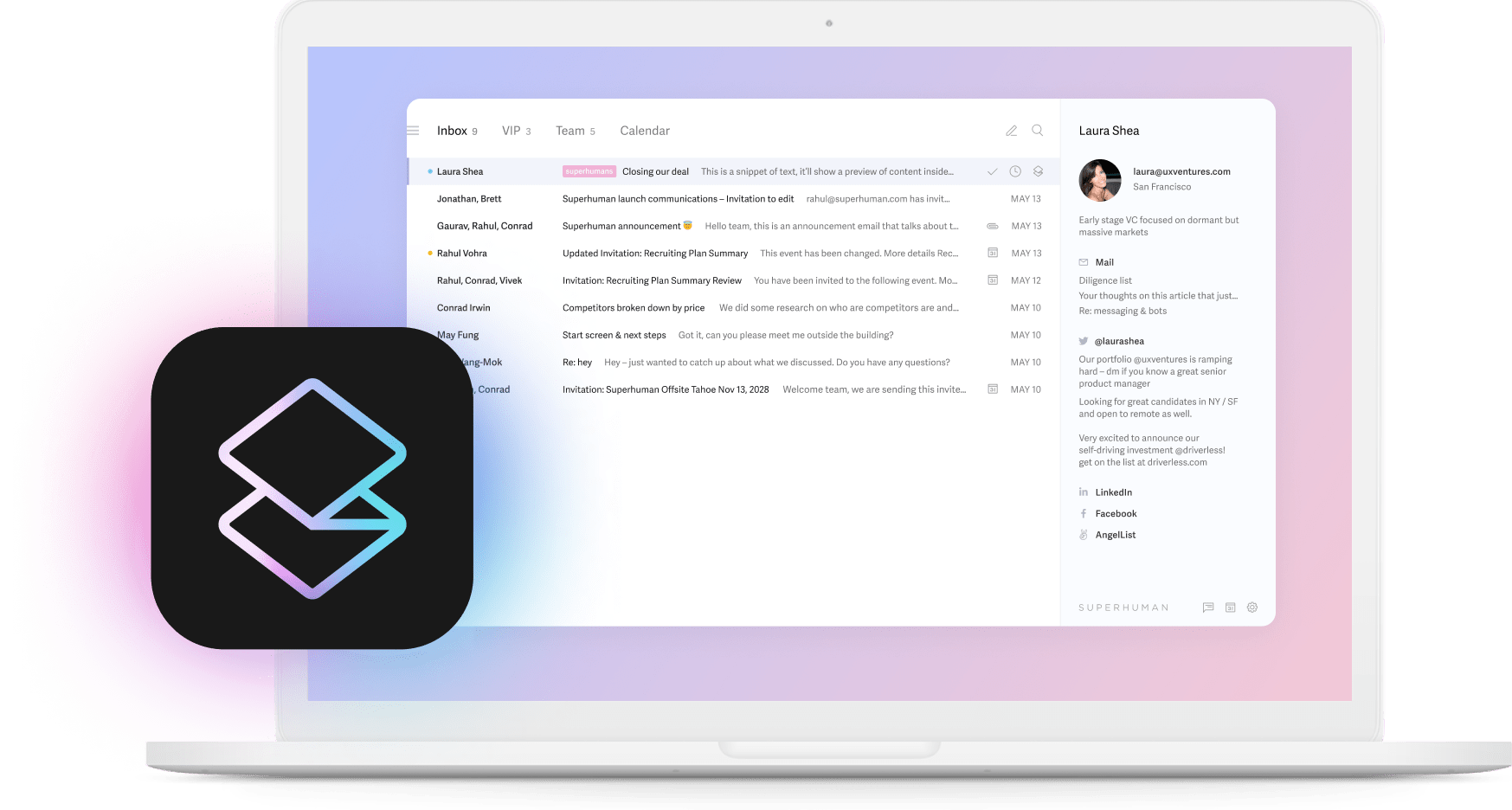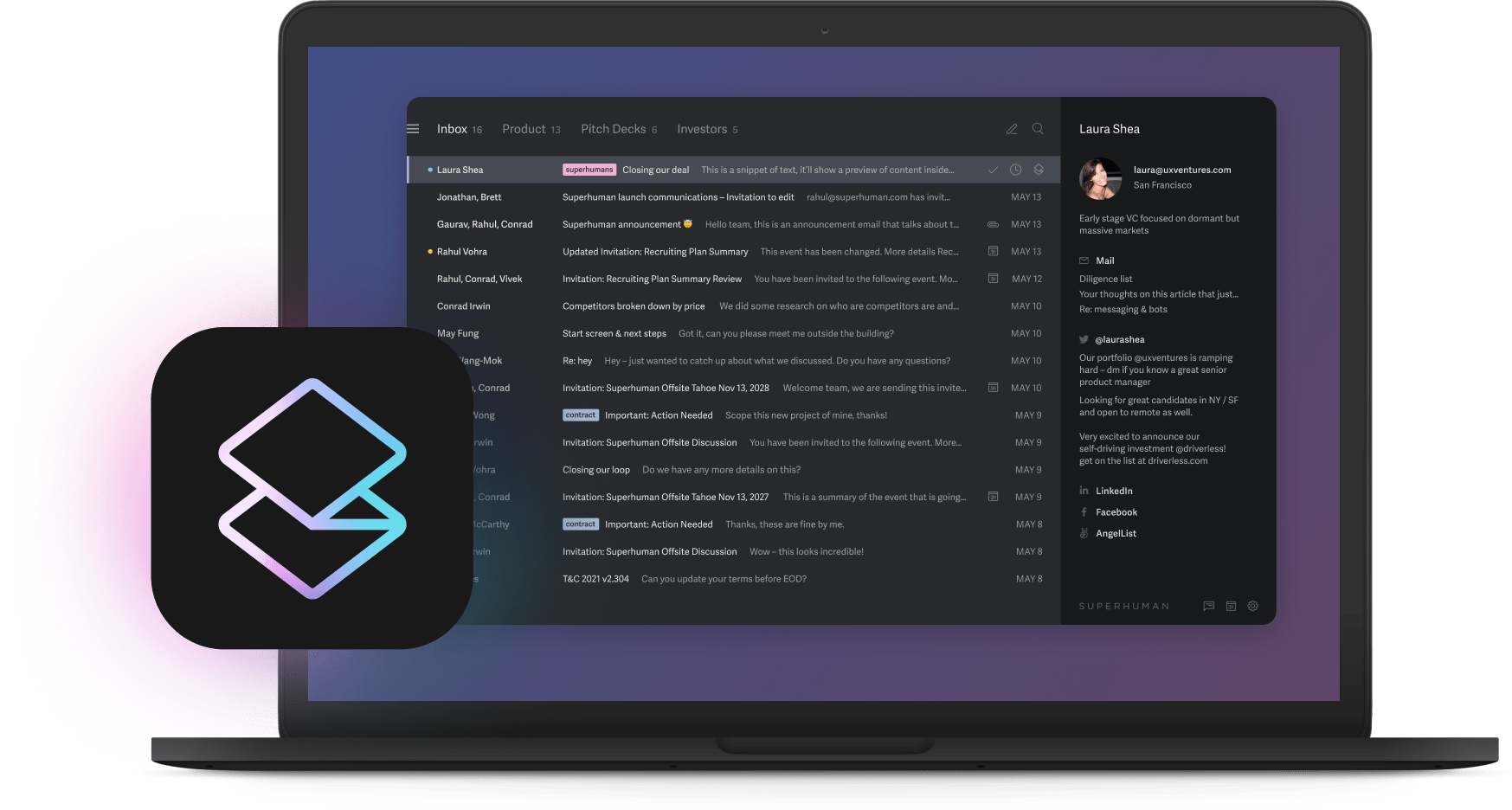
You know that sinking feeling when you hit reply-all and immediately realize the entire company just read your sarcastic comment about the quarterly meeting? Bad email habits create these moments. They damage relationships, slow down decisions, and turn simple communications into workplace friction.
Good email etiquette transforms these daily interactions into something powerful. Instead of dreading your inbox, you build trust, save time, and actually get things done faster. The difference between professionals who excel at email and those who struggle often comes down to following clear, practical guidelines.
These 15 rules cover everything from writing subject lines people actually want to open to managing those email threads that somehow involve half your company. Whether you're a busy professional trying to stay on top of everything, a team lead coaching your staff, or someone looking to make a strong first impression, you'll find examples and advice you can use immediately.
1. Write subject lines people want to open and keep formatting clean
Your subject line determines everything. People decide whether to open, ignore, or delete your email based on those few words. Clear subject lines get opened more often and help everyone manage their inbox better.
Skip these vague subjects:
"Meeting" "Quick question" "FYI"
Write these specific ones instead:
"Q3 Budget Review - Thursday 3 PM" "Action Required: Contract approval by Friday" "March sales report attached - review by EOD"
Keep your formatting simple too. Stick with fonts people recognize like Arial, Calibri, or Times New Roman. Use 11-12 point size. Skip the decorative fonts, weird colors, or fancy formatting that makes you look like you're trying too hard or breaks on different devices.
Split Inbox automatically finds your high-priority messages when you write clear subject lines. Superhuman's clean formatting makes sure your emails look professional everywhere they land.
Try Superhuman2. Start right and match how formal you need to be
How you open an email sets everything that follows. "Hey" works fine when you're messaging your team about lunch plans. "Hi Maya" or "Good morning, Dr. Chen" works better when you need to show respect or don't know someone well yet.
Keep the same tone throughout your email. If you start formal, stay formal. If you're being casual with a colleague, don't suddenly switch to corporate speak halfway through. Skip sarcasm entirely, it rarely works in writing. Avoid writing in ALL CAPS unless you want to sound angry.
Think about who you're writing to:
- Lawyers and finance people expect more formal language
- Creative and tech teams usually go more casual
- Professional greetings show respect from the first word
- Matching your tone prevents confusion and builds better relationships
Snippets save your go-to greetings for different types of people. Previous Threads shows you how you've talked with someone before so you can stay consistent.
3. Get to the point and make it easy to read
Say why you're writing in your first sentence. People shouldn't have to guess what you want or why they're reading your email. Cut out words that don't add meaning. Get straight to what matters.
Here's what happens when you don't:
"I wanted to reach out regarding the upcoming quarterly budget review meeting that we discussed last week in passing, and I think it would be beneficial for all stakeholders to attend so we can discuss the various line items and departmental allocations that need to be finalized before the end of the fiscal quarter, particularly the marketing spend which has been a topic of concern lately."
Here's the same thing, but readable:
"Please join the Q3 budget review meeting Thursday at 3 PM.
We'll finalize three key decisions:
• Marketing spend allocation ($50K pending)
• Department budget adjustments
• Q4 planning timeline
Meeting link attached."
Break up long paragraphs. Use bullet points when you have multiple things to cover. Writing clearly shows you respect someone's time and makes them more likely to actually read and respond to what you wrote.
Superhuman AI helps you cut wordy drafts down to size with the "Shorten" command. Markdown shortcuts let you add bullets quickly. Instant Reply works better when your original email is well organized.
4. Stop reply-all chaos and manage long conversations
Reply-all creates email hell when you use it wrong. Before you hit that button, ask yourself: does everyone really need to see this? Your "Thanks, got it" response doesn't need to go to 47 people.
Long email chains get confusing fast. When you're jumping into a conversation that's been going on for days, start with a quick summary: "Quick recap: We agreed on the March 15 launch date and we're finalizing the marketing budget." This helps everyone remember what's happening and saves new people from reading 20 emails.
When you need to follow up on something:
- Wait 2-3 days for stuff that's not urgent
- Be polite but direct: "Checking in on the proposal below. Do you need anything else from me?"
- Smart reply habits keep conversations focused instead of spiraling
- Include enough context so people don't have to dig through old emails
Superhuman's conversation sidebar shows you everyone who's included before you send. Auto Summarize turns long threads into the key points. Reminders make sure you follow up when you said you would.
5. Use CC and BCC the right way and describe your attachments
CC and BCC do different things. CC lets everyone see who else got the email. Use it when you want transparency. BCC hides the recipient list. Use it when you're protecting privacy or avoiding reply-all disasters with big groups.
Always tell people what you're attaching and how big it is. "Attached: Q3 Financial Report (PDF, 2.3 MB)" tells them exactly what they're getting and whether their phone can handle downloading it. Good attachment notes prevent confusion and look professional.
Split Inbox automatically sorts your internal and external conversations, which makes it easier to decide who needs to be CC'd and who doesn't.
6. Fix your typos and go easy on the exclamation points
Proofreading matters because typos make you look careless. Read your email out loud before sending it. This catches weird phrasing and missing words that your brain fills in when you read silently.
Limit exclamation points in work emails. "Great job!" sounds enthusiastic. "Great job!!!" sounds like you're shouting or being sarcastic. Emojis work fine for internal team stuff but skip them in formal business emails where they might not display right or seem unprofessional.
Quick things to check before sending: □ Read it out loud, does it sound natural? □ Are names and email addresses right? □ Did you actually attach what you said you attached? □ Any autocorrect mistakes that changed your meaning? □ Emoji use matches your industry and relationship
Superhuman's spell-check (⌘⇧P) catches the obvious mistakes. The clean interface keeps you from going overboard with formatting that looks unprofessional.
7. End with clear next steps and look professional
Tell people exactly what you want them to do. "Please approve the budget by Wednesday 5 PM ET" works better than "Let me know your thoughts." Vague requests get vague responses or no responses at all.
Pick sign-offs that match your relationship and industry. "Best regards" for formal stuff, "Best" for regular business emails, "Thanks" when you're working together on something. Skip "Cheers" if you work in banking or law.
Put this info in your signature:
- Your full name and job title
- Company name
- Direct phone number
- Professional email address
- LinkedIn profile if it's relevant
Clear next steps and complete contact info make it easy for people to respond and reach you however works best for them.
Snippets store your sign-offs and signatures so they're always consistent. Team-wide signature management keeps everyone's emails looking like they work for the same company.
8. Respond quickly and time your emails right
People expect responses to work emails within 24 hours. Quick responses show you respect someone's time and keep projects moving. For urgent stuff, respond within a few hours. For complex requests, at least acknowledge you got it and say when you'll have a real answer.
Don't send emails at weird times. Hitting send at 11 PM your time might mean it arrives at 6 AM for them, which feels like pressure to respond immediately. Good timing gets better responses and shows you think about work-life balance.
Response timing that works:
- Urgent business stuff: Within 4 hours
- Regular requests: Within 24 hours
- Complex things: Acknowledge quickly, then give a timeline
- FYI emails: No response needed
Read receipts show you which emails people have actually seen. Send Later (⌘⇧L) lets you write emails when you think of them but send them at reasonable times. Reminders make sure important follow-ups don't get forgotten.
9. Use templates wisely and give credit where it's due
Templates speed things up, but customize them so they don't sound robotic. Save standard responses for meeting confirmations or project updates, but always add specific details that show you're paying attention to each situation.
Give people credit when they help you. "Thanks, Priya, for drafting the presentation. CC'ing Sam who provided the data" keeps everyone informed and acknowledges good work. People remember when you recognize their contributions.
Ways to make templates work:
- Add placeholders for personal details
- Include situation-specific information
- Keep your natural writing voice
- Thoughtful recognition builds stronger work relationships
Snippets with variables let you personalize common responses quickly. The :thanks snippet gives you fast access to professional ways to show appreciation.
10. Handle out-of-office messages and confirmations
Good out-of-office messages include your exact dates, who to contact for urgent stuff, and when you'll respond to emails. "Out of office March 10-17. For urgent matters, contact Sarah Johnson at sarah@company.com. I'll respond to emails by March 20" tells people everything they need to know.
Confirm you got important emails to prevent people from wondering if their message disappeared. "Got the contract. Reviewing with legal and will respond by Friday" acknowledges their email and gives them a timeline.
Out-of-office essentials: □ Exact dates you're away □ Alternative contact for urgent stuff □ Realistic timeline for when you'll respond □ Professional auto-replies maintain relationships even when you're not available
Auto-reply settings handle absence management automatically. Read indicators help you figure out when confirmation responses actually add value instead of just creating more email.
11. Think globally and keep things private
When you work with people in different countries, avoid idioms and slang that don't translate. "Let's touch base" or "circle back" might confuse someone whose first language isn't English. Use clear, direct language that works everywhere.
Think about time zones and holidays when you set deadlines. "Please respond by end of business Thursday" means different things in different places and might conflict with local holidays you don't know about.
Global communication tips:
- Use clear language that translates well
- Include time zones when scheduling anything
- Research holidays before setting deadlines
- Write carefully because your email might get forwarded to people you never expected to read it
Send Later helps you time emails properly across time zones. Conversation history gives you context about how different people prefer to communicate.
12. Build relationships through personal touches
Use people's names and reference previous conversations or mutual connections. "Following up on our discussion about the Chicago expansion" immediately reminds them what you talked about and shows you were paying attention.
Personalized emails get better responses than generic ones. Mention specific details about someone's work, recent achievements, or people you both know. This shows genuine interest in them as a person, not just someone who can do something for you.
Personalization that works:
- Reference previous conversations or shared connections
- Mention specific things about their work or recent wins
- Use their name and proper titles
- Smart introductions highlight relevant experience while staying focused on them
Social Insights gives you context about people's professional background and recent activities. Conversation history helps you maintain continuity in ongoing relationships.
13. Structure your emails logically and format them well
Good emails follow a pattern that makes sense. Start with why you're writing, provide the details they need, say what you want them to do, and close professionally. Smart email structure makes sure important information gets communicated clearly.
Put the most important stuff first. Busy people often only read the first few lines, so front-load your key information and requests. Save background details for later in the email.
Email structure that works:
- Clear subject line that explains the purpose
- Greeting that matches your relationship
- Purpose statement in the first sentence
- Supporting details organized logically
- Specific action you want them to take
- Professional closing with complete signature
Superhuman AI helps with logical structure and flow. Formatting shortcuts keep your emails looking consistent and professional.
14. Make team email work without driving everyone crazy
When you're emailing multiple team members, be clear about who needs to do what and who's making decisions. Don't just throw everyone on an email and hope it works out.
Sometimes email isn't the right tool. Complex discussions might work better on a call with email follow-up to document what you decided. Use email for decisions and documentation, not brainstorming or urgent conversations.
Team email guidelines:
- Include decision-makers from the start
- Add context when you bring in new people
- Be clear about roles and who's responsible for what
- Document decisions so you can find them later
- Ask yourself if email is really the best way to have this conversation
Shared Conversations let teams discuss things within email threads. Team Comments help with quick decisions. Split Inbox keeps internal and external conversations separate so you can handle them differently.
15. Stay consistent and maintain standards
When your whole team emails consistently, it makes your company look more professional and organized. Use similar language, formatting, and signature styles that reflect how you want people to think about your company.
Double-check important emails before sending them. Review who you're sending to, make sure attachments are right, and confirm your message is clear. Mistakes in high-stakes emails can damage relationships or create legal problems.
Consistency checklist: □ Use company-approved language and terminology □ Keep signature formats consistent across the team □ Use standard greetings and closings □ Maintain professional tone in all communications
Team-wide settings keep everyone consistent. Snippets maintain appropriate language and formatting. AI tone matching helps you keep a professional voice across all your communications.
Stop fighting your inbox and start winning with it
We've all been there. You follow every email rule perfectly, craft thoughtful messages, and still spend half your day managing your inbox instead of doing real work. Email volume keeps growing while the pressure to respond quickly and professionally stays high.
Here's how Superhuman changes the game
Superhuman turns good email habits from a manual checklist into automatic behavior. The AI learns how you write to specific people and matches your tone and voice without you having to think about it. Instead of constantly correcting yourself, the system learns from your writing patterns over time.
Features that make etiquette effortless:
- Split Inbox automatically prioritizes what matters most
- Send Later times your emails perfectly across time zones
- Snippets keep your responses consistent and fast
- Auto Summarize turns long threads into key points
- Social Insights give you context for better personalization
- Reminders ensure follow-ups happen when they should
The difference this makes
Teams using Superhuman save 4 hours per person every week and respond 12 hours faster while handling twice as many emails in the same time. Your inbox feels 10x lighter and daily workflows become effortless.
When intelligent automation handles the mechanical parts of professional communication, email becomes what it should be: a powerful way to build relationships, make decisions quickly, and drive real business results. Good email etiquette stops being work and starts being your competitive advantage.





